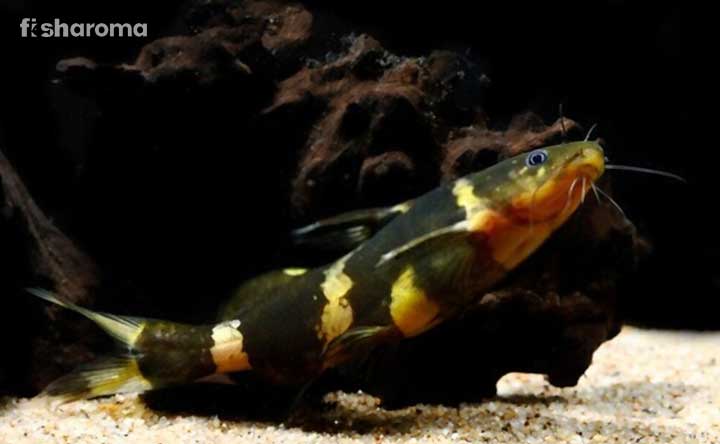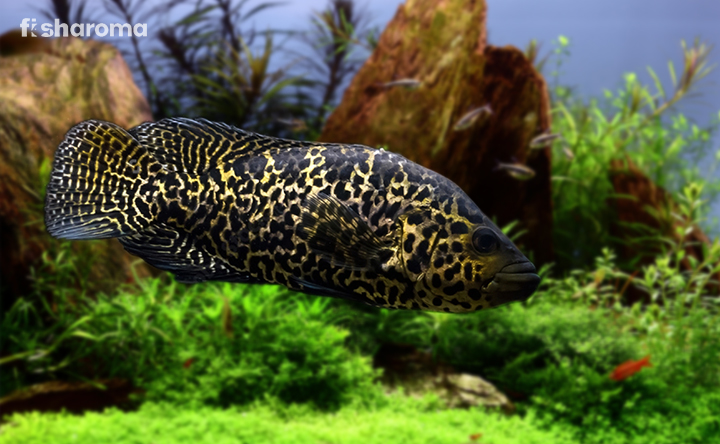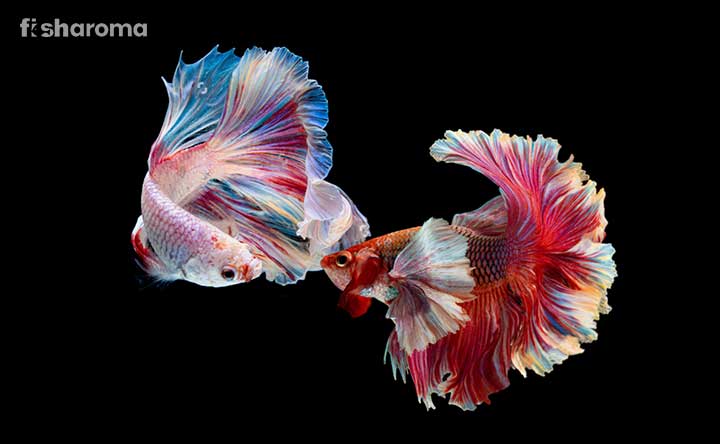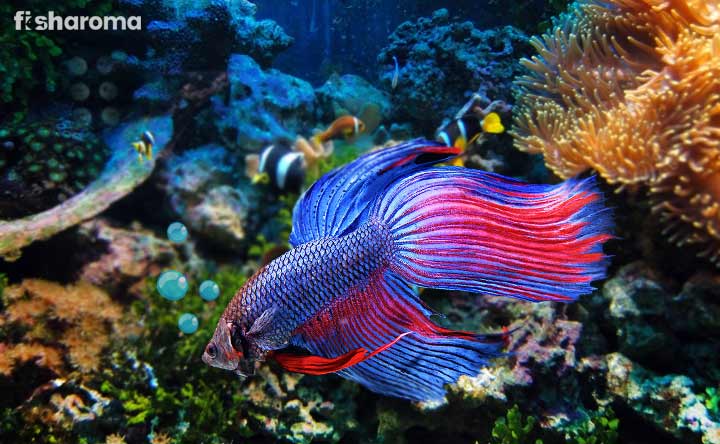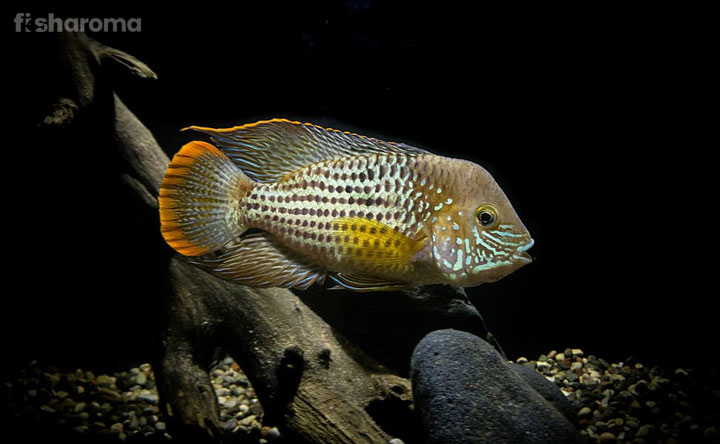Cockatoo Cichlid & An Expansive Care Guide To This Colourful Fish

- Origin And Habitat Of Cockatoo Cichlid
- Appearance Of Cockatoo Cichlid
- Behaviour Of Cockatoo Cichlid
- Lifespan Of Cockatoo Cichlid
- Diet Of Cockatoo Cichlid
- Tank Requirements For Cockatoo Cichlid
- Water Type Of Cockatoo Cichlid
- Compatibility Of Cockatoo Cichlid
- Breeding Of Cockatoo Cichlid
- Diseases Of Cockatoo Cichlid
- Summary
The Cockatoo Cichlid, a magnificent freshwater fish, is known for its striking resemblance with Cockatoo birds. These fishes are small and sometimes become territorial. Their colouration is so appreciated, that breeders use them to their advantage. As a result, aquarists get many colour variations of Cockatoo Cichlids. However, their colour and temperament are largely dependent on their maintenance. Here, we will guide you on how to take care of these colourful water angels.
Key Specifications Of Cockatoo Cichlid
This is an instant way to get a grip of the entire species, as far as petting it in your home aquarium is concerned.
| Also Known as | Big Mouth Apistogramma, Cockatoo Dwarf Cichlid & Crested Dwarf Cichlid |
| Origin | South America |
| Lifespan | 3-5 years |
| Colours | Red, orange, black, & yellow |
| Temperament | Peaceful |
| Size | 2-3.5 inches |
| Diet | Carnivorous |
| Reproduction | Egg-laying |
| Maintenance Requirements | Easy |
| Tank Size | 40-50 gallons |
Overview
Scientifically called Apistogramma cacatuoides, this fish belongs to the family of Cichlidae. It derives from the genus Apistogramma, which itself is a big one, in terms of the number of species included in it. The Cockatoo Cichlids are usually a gentle species that have a tendency to be aggressive at certain times. These small fishes require proper swimming space, but even that doesn’t call for an extra-large tank. They can do well with a moderately spacious one. Their diet is also easily available for the aquarists, and on the whole, they are low maintenance. Another good thing about them is their fair lifespan, which earns them extra brownie points without a doubt.
Origin And Habitat Of Cockatoo Cichlid
Cockatoo Cichlids are a South American species, inhabiting the Amazon River basin. They commonly occur in Peru, Brazil and Bolivia. Their natural distribution is extended from Tabatinga River to Solimoes and Ucayali Rivers.
Cockatoo Cichlids swim in tributaries, creeks, and backwaters, which are slow-moving waters, mostly shallow in nature. There are plenty of leaf litters in the clean water bodies they swim in.
Appearance Of Cockatoo Cichlid
Since these fishes are blessed with robust colours, breeders breed them entirely for many variations of the same species. They are successful, and to an extent where you can find captive-bred species have more colourful features than wild fishes. This is because commercial breeders make such calculative breeding where they can utilize and bring out the most vibrant colouration.
So, in comparison with these captive-bred species, their wild cousins look much paler when their appearance is concerned. Also, both the wild and captive-bred species are sexually dimorphic. Their body is long and their mouth is comparatively big in contrast to their body, and it has thick lips.
Size
The adult Cockatoo Cichlids can be sized 2-3.5 inches long. While males are mostly around 3.5 inches, females can be maximum of 2 inches. They are tiny and there is no such case where they can outgrow their standard size in a mentionable way.
Colour
The body has a greyish base colour, with some black markings throughout. Male Cichlids have orange or reddish caudal and dorsal fins. In female fishes, such colourations are paler and not prominent. Females have pale yellow colouration that gradually darkens and becomes more prominent during their breeding time. The male fishes have signature dorsal rays with clear ventral fins. Female Pelvic fins are much darker than males and the latter have forked tails.
Behaviour Of Cockatoo Cichlid
The Cockatoo Cichlids are docile creatures, with rarely being territorial, especially during the mating time. There might be some clash between male Cichlids, but that happens if there is not enough swimming space, otherwise, these fishes can be compatible with others without any issue and can be kept inside a community fish tank.
These Cichlids swim mostly in the middle and bottom levels of the water. There is some unique behaviour of such fishes, where they can be seen digging out the sand and eating them. This might seem quite odd, but that shouldn’t be a reason to worry. They don’t consume the sand, but it might seem like, actually, they look for food, scattered on the substrate. Once they get the food particles, they will throw out the sand from their mouth.
Cockatoo Cichlids might show some territorial aggression and they are pretty defensive regarding this. However, these are all pretty subjective and there is no surety that all-male fishes will sport such behaviour.
Lifespan Of Cockatoo Cichlid
A Cockatoo Cichlid can live for around 5 years. Some species can live for 3 years as well. However, for any captive-bred fishes, it is a common thing that their lifespan depends on the type of care they receive from their owner.
Diet Of Cockatoo Cichlid
Cockatoo Cichlids are carnivorous species and they feed on smaller insects and larvae in the wild. So, while you are petting them, make sure you are giving them everything that they need to ensure their dietary requirements. In their natural domain, Cockatoo Cichlids are predators. So, their natural instinct is to prey on potential victims.
Supply Brine Shrimps, Tubifex, bloodworms, and insects on a regular basis. You can easily provide the flake or pelleted foods as well. Chop off the meats so that the tiny fishes can fit them inside their mouth.
For live food, many aquarists harvest or breed the invertebrates, crustaceans that you intend to feed your Cichlids. This way you can eliminate the chance of parasitic or bacterial infection that otherwise comes from live foods.
Tank Requirements Of Cockatoo Cichlid
We have already stated that these Cichlids prefer to stay either in the middle or in the bottom zones of the water. So, the tank needs to have proper diameter accordingly. Here we will tell you about the required tank size and what should be going inside it, to make it more appropriate for such Cockatoo Cichlids. You should prepare the Cichlid tank before you place your fish in it.
Tank size
The tank needs to be around 30 gallons so that at least a pair of Cockatoo Cichlids can stay comfortably. If there are some more fishes, then this tank is enough for them as well. Make sure the tank’s length is enough to accommodate the Cichlids.
Tank Lid
A lid or cover is important so that the water remains clean and nothing from outside can get inside the tank.
Substrate
Keeping and maintaining a proper substrate is important, but it has to be sand based. We have already mentioned that Cichlids often dig out the sand to look for food, that is why sand is the safest option. Otherwise, uneven rocks or even gravels can lead to injury to these fishes.
Since the fishes, especially the males are so colourful, a dark coloured substrate is important to bring out those shades. This will happen mostly for two reasons, one is the contrast factor, and the other one is, such dark substrate is similar to their natural habitat, so the fishes will be more comfortable. There will be no stress, and when a fish is happy from within, it will show through its body language and colours.
Moreover, the substrate will ensure that the fishes can continue their food digging tendency without harming their bellies or fins. The substrate is an important factor and you can decorate it as much as you want, but leave some room for the fishes.
Filter
Any aquarium would need a filter, to say the least. Filters not only make sure the cleaning aspect, rather it is for aerating the tank water as well. Filters also control the water current of the tank. Cockatoo Cichlids are habituated to swim in the slow currents. So, you have to install a filter that can create slow water flow inside the aquarium. The best option is to go for an External Canister Filter that will serve both the purpose of maintaining water flow and cleaning the water.
Ornaments
The substrate of the tank should have some essential decorations that would give the fish some private moments. It should have caves, smooth rocks, driftwoods, bogwoods, and so on. The space dividing items will let each fish have their own territory and the chance of getting violent would be much less. You can be creative and try out different types of decoration, but you can’t forget that the tank shouldn’t be cluttered at any cost. Lack of a swimming zone would result in stress in the fish, it may lose colour and health if such a situation persists for a long time.
Lighting
The lighting that you would need for Cockatoo Cichlids is subtle and subdued. They can’t tolerate extremely bright lights, because in their natural habitat they are accustomed to moderate lighting around them. However, when it comes to the setting of the aquarium, the owner needs to spot the fish, for many occasions, to observe, to feed it and so on. The owner also needs to figure out if the fish is alright or showing any irregular postures or not. This is to prevent any health complications, so lighting is undoubtedly the most important thing.
So, while you make sure that the lights are good enough for you to locate the fish inside the tank, they (lights) are not too harsh for the fishes. Something in the middle would be good for both of you and the fish.
Presence Of Flora
You can certainly put a lot of plants inside the tank as the fishes like them. You can try both anchored as well famous floating plants so that they can subdue the effects of the lights further. This would make the tank accurately like their natural home. The plants and the aquascaping should contribute to uplifting the mood of the fish, because it stimulates their sense of security, and they look healthy and happy at the same time. The names of the plants that you can put inside the aquarium are listed below.
- Anubias
- Cryptocoryne
- Taxiphyllum
- Microsorum
These are the aquatic plant genus, and any plant from such groups are suitable Cockatoo Cichlids. These plants will keep the water quality clean and purified as well.
Cleaning Method
Cockatoo Cichlids are fishes of clean water so slight pollutants in the water can harm them. Besides, changing the water, you need to take care of the ornaments that you use for the fish. Clean them thoroughly, even if it means taking them out of the tank and washing them separately and properly. Besides cleaning the decorations, make sure that the glass, lid, and other essential things of an aquarium should get cleaned in the process as well.
Water Type Of Cockatoo Cichlid
Cockatoo Cichlids come from clear waters which are soft and have moderate acidic content. The water needs to maintain its parameter in a strict way because the fishes can’t handle any drastic or sudden change because of their sensitivity.
However, there is a common notion that these fishes are actually okay with changes in their water. Because, in the wild, there might be some changes, always going on, and fishes there don’t face any problems. This is a loaded argument because we believe that there shouldn’t be any comparison between the wild and captive-bred species. Their immunity is different and so is their health. So, whatever happens in nature shouldn’t be taken as an example for the home-bound aquarium.
From temperature to its hardness, there is a certain range for everything that we are stating in the following.
Temperature
The desired water temperature of the tank should be within 22-23 Degrees Celsius. It should not drop, nor should it increase at any point of time. However, if you think there are water fluctuations, especially in the lower range, then install a heater to keep up the warmth. If there is no possibility of your room temperature going down to 16 Degrees Celsius, then a heater is not required.
pH Level
The slightly acidic water needs to be 5.5-7.0.
Hardness
The general hardness of the water should range between 2-20 dGH. Many people believe that the range window should be smaller and it should be spanning within 9-20 dGH as well.
Replacement Procedure Of Water
The water change is an integral procedure to keep the quality of the tank at its best. The water parameter should be checked and tested frequently. When it comes to changing the water that needs to be on a bi-weekly basis maximum. Try to maintain the process on time, and don’t skip or delay until any contingency arrives. This is a certain way to make the fishes healthy. If you are able to do it even on a weekly basis, then 10% of a water change should be done and if you are fine with the bi-weekly change, then 20% for water change would be great.
Compatibility Of Cockatoo Cichlid
Cockatoo Cichlids are generally docile and get along with other gentle species. They become aggressive when it is the breeding time, which is quite a common phenomenon in the fish world. As far as compatibility issues are concerned, they can stay well in a community fish tank as well as in a Cichlid-specific tank.
If you wish to avoid studying various fishes’ temperamental issues in order to select the right tank mates for your Cichlids and want a fish tank with only one kind of fishes, (i.e Cockatoo Cichlids) then choose a harem. It means there will be one male fish along with 6-7 female Cichlids. This is because two males can get into an ugly fight, owing to their breeding or territorial aggressive trait. You can keep multiple male Cockatoo Cichlids only if you have a much bigger tank with lots of plants and decorative items in it.
Suitable Tank Mates
As we have said, this fish can be a wonderful selection for a colourful community tank. The trick is to choose fishes that don’t interrupt Cockatoo Cichlids in their swimming zone and vice versa. These Cichlids mostly stay in the middle layer, or in the bottom, so choose fishes that don’t go to those two zones at all. The suitable tank mates will be those who mostly hover on the upper layer. Some of the compatible mates are
- Dwarf Gourami
- Kuhli Loach
- Cardinal Tetra
- Julii Cory
- Glowlight Rasbora
- Dwarf Rainbow Fish
Unsuitable Tank Mates
Aggressive fishes with a predatory instinct don’t make good tank mates for Cockatoo Cichlids. There are lots of fishes which can harass the Cichlids, because fishes are so colourful and small. Their size and shade can both be intimidating for predator fishes and the Cichlids can be an easy target. Also, the same logic can be applied when it comes to smaller (than Cichlids) fishes, who can be a victim of such Cichlids’ aggression.
- Snails
- Crabs
- Shrimps
Breeding Of Cockatoo Cichlid
With Cockatoo Cichlids, breeding is not as smooth as it is with other species. You need to set up a separate breeding tank with lots of caves and plants. The mating couple will use the caves as their egg-laying and fertilization process. The male and female, if you have chosen a pair, should be kept on a protein-enriched diet prior to their breeding. The foods that you can give them are listed below
- Brine Shrimps
- Earthworms
- Daphnia
- Cherry Shrimps
- Black worms
This maximizes the chance of their successful breeding. Now, make sure that the mating couple gets their sufficient space inside the tank. Both of their colourations will become more vibrant when their biological cloak hits the bell of spawning. The male will try to entice the female and win its attention, and after a successful phase, the female will indicate that it is ready to spawn. The female fish will do so by taking the male inside one of its caves, that it had chosen already. It will lay around 80 eggs and then the male fish will gradually fertilize them all.
Once the fertilization is completed, you have to take out the male from the tank because female fish will show parental instinct and will guard the eggs until they hatch successfully. The hatching takes around 7-10 days and immediately after young fishes or “fry” appear, their mother guides them for a few days. This is because the female or mother fish wants to ensure that its fries are properly fed. The young fishes quickly grow up and attain sexual maturity within 5 months or so. The female fishes show them the way to get out of the spawning cave.
During this time, you can offer Microworms or Brine shrimps to these growing fishes. Once they are on their own, separate the mother as well. These young or juvenile fishes are ready to take on the world and by this time, they can be gradually introduced to a standard fish tank. After the fishes are growing independently, the mother fish can start spawning for the next phase if there is a male fish introduced.
Diseases Of Cockatoo Cichlid
There are a lot of ailments that you need to save your Cockatoo Cichlids from. The fishes are susceptible to such diseases which mostly occur due to lack of swimming space, poor water, and insufficient nutrition. All of these can lead to stress that slowly but effectively has a bad impact on health. Apart from these, there are some infections caused by bacteria and parasites.
The things that affect a Cockatoo Cichlids are,
- Ich or white spot disease
- Cestoda Infestation
- Costia Disease
- Metacercaria Infection
- Flatworm related infection
- Skin Flukes
In such cases, you need to keep the fish in a separate tank so that the affected fish can’t transmit the disease into others. Consultation with a professional vet would be ideal and treat the fish accordingly.
However, it is always recommended to maintain the water condition and the dietary routine at check, because the fish are mostly affected by these two reasons. Also, the live food that you provide has the chance of carrying some infectious worms or bacteria inside them, proper caution in that scenario is an absolute must.
Another preventive way of diseases is to quarantine any new fish, regardless of its type, or even plants prior to its addition to the fish tank. This phase would let you see if the additions have any problems or not.
Summary
Cockatoo Cichlids are tiny swimmers, occupying the middle zone of a fish tank, with frequent visits to the bottom. They are good to cohabit with other freshwater fishes, who share similar requirements in terms of their diet, water temperature, and hardness. Their colourful body is definitely one of the perks of keeping such fishes. From its maintenance to its breeding, everything can be done if the owner is observant and careful enough.
Other Similar Care Guides
If the above article is good enough for you, we would like to have your attention in the following articles as well.
- Dragon Wrasse – Dragon Wrasse is a marine fish that is also known as Reindeer Wrasse because it has a couple of appendages. The fish changes its appearance to something entirely different while it attains maturity.
- Blood Parrot Cichlid – The hybrid fish comes in a stunning red to orange shade. This is a freshwater fish that can live for around 15 long years.
- Jewel Cichlid – The omnivorous species, native to West Africa, is a known aggressive fish. It requires warm water to survive. It grows to a maximum of 5.5 inches.

